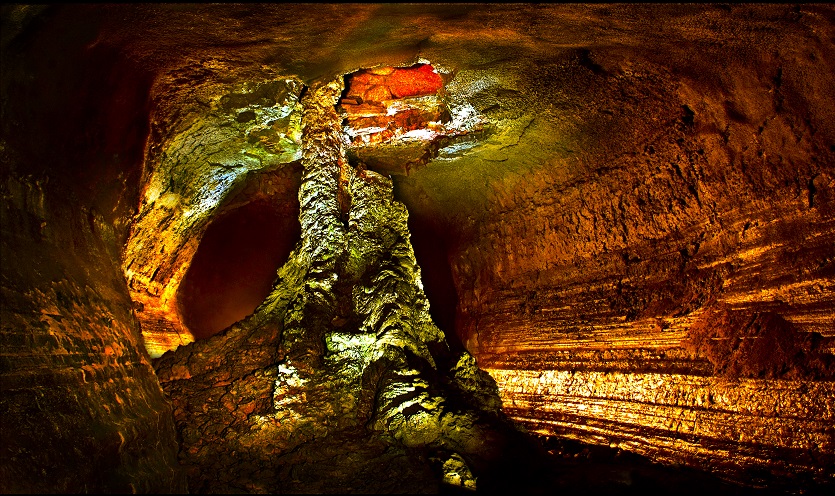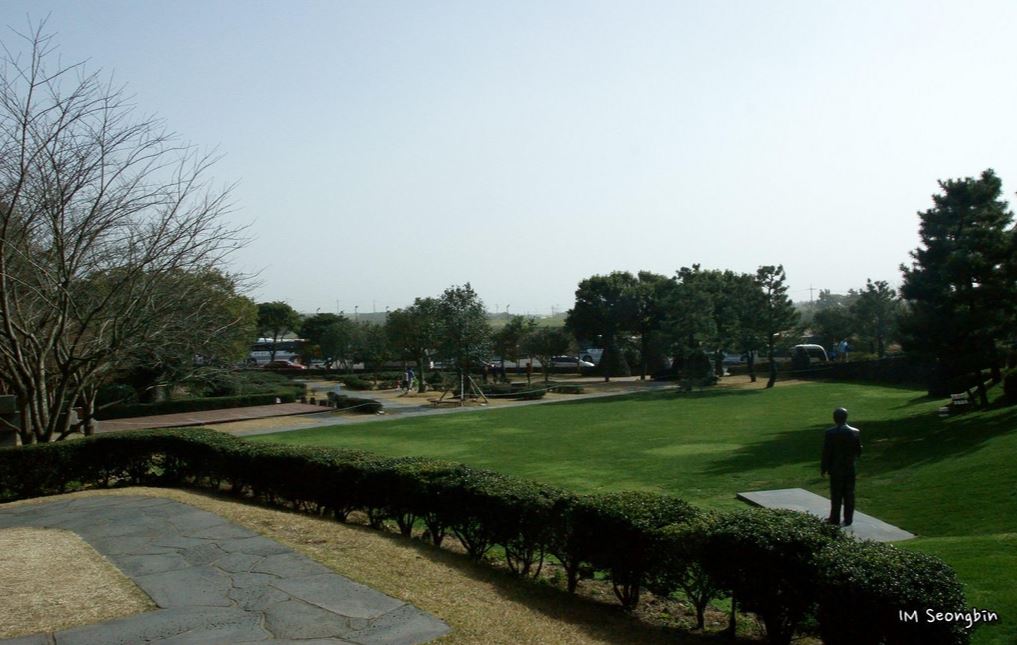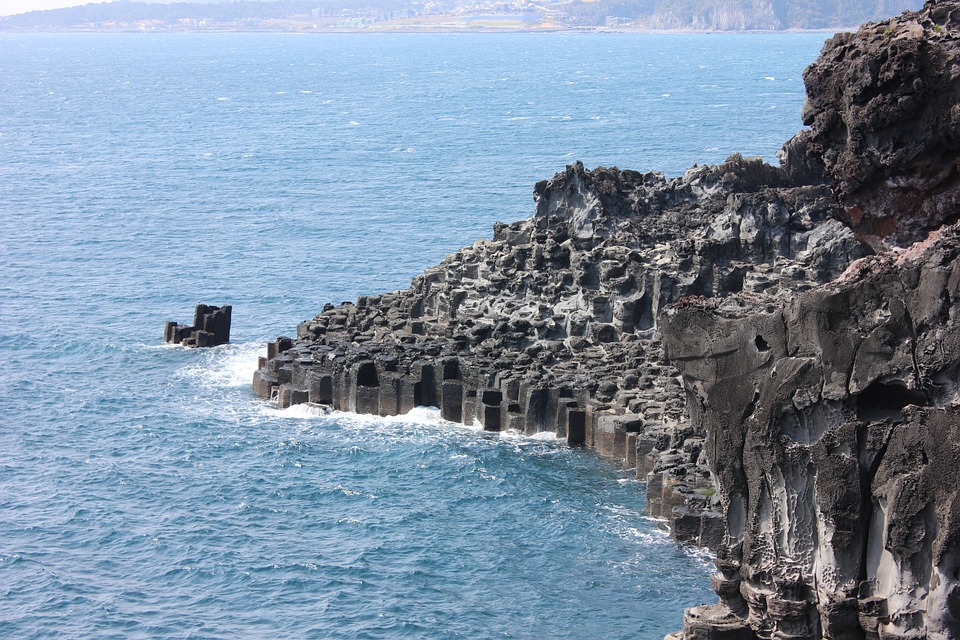Tourist Attractions
More comprehensive information can be found at following sites.
In Jeju-si (Northern Part of Jeju Island)

Mt. Hallasan National Park Mt.Hallasan stands tall in the middle of Jeju Island. It is also called Mt.Yeongjusan, meaning a mountain high enough to pull the galaxy. Mt.Hallasan is widely acknowledged by scholars for its research values. Designated as a National Park in 1970, there are 368 parasitic mountains called "Ohreum (peaks)" around Mt. Hallasan.From its warm climate to the cooler areas, Mt.Hallasan is famous for its vertical ecosystem of plants. Over 1,800 kinds of plants and 4,000 species of animals (3,300 species of insects) are known to exist here, and due to the well-developed climbing course, you can carefully observe the surroundings.

Manjanggul Cave Manjanggul Cave, situated at Donggimnyeong-ri, Gujwa-eup, North Jeju, 30 km east of Jeju City, was designated as Natural Monument No. 98 on March 28, 1970. The 7,416-meter long cave has been officially recognized as the longest lava tube in the world. The annual temperature inside the cave ranges from 11℃ to 21℃, thus facilitating a favorable environment throughout the year. The cave is also academically significant as rare species live in the cave. Created by spewing lava, "the lava turtle", "lava pillar", and "Wing-shaped Wall" look like the work of the gods. It is considered to be a world class tourist attraction.

Sanggumburi Crater San Gumburi is the government-designated Cultural Properties Natural Monument No. 264. Along with the approximately 360 parasitic volcanic cones in Jeju Island, it exploded under a geological bridge, erupting many times without any further explosions, and formed a crater with a hole. The area inside the crater is 300,000㎡ with an inside bottom circumference of 756m, an outer circumference of 2,070m, and a vertical height of 130m. It is bigger and deeper than the crater of Mount Halla. It is open from 9:00 a.m. to 5:00 p.m. from November 1 to February 28, from 9:00 a.m. to 6:00 p.m. from March 1 to July 14, from 9:00 a.m. to 7:00 p.m. from July 15 to August 31. and from 9:00 a.m. to 6:00 p.m. from September 1 to October 31.

Seongpanak Seongpanak is one of the parasitic volcanoes on Jeju-do island. Parasitic volcanoes are smaller volcanoes formed by lava bursting through the edge of the main volacano, and there are over 350 on Jeju-do Island. Seongpanak is 1,215m high and situated between Jocheon-eup, Bukjeju-gun and Namwon-eup, Namjeju-gun. The name came from the shape of the vertical cliff that spreads roughly 500 meters outward and resembles a fortress (seong) made of wooden boards (pan). With its thick verdant forest, Seongpanak has a unique atmosphere all year around. The road here is clear and wide, but a bit uncomfortable to walk because of many rocks. The azaleas create a pink blanket in the spring, and blends well with the clear waterfall in the area.

Bijarim Forest Strolling through the Bijarim forest is said to have many healthful effects on your body by helping to relax the blood vessels, relieve fatigue and restore your natural body rhythm. Within the forest is a youth training center and camp grounds that are equipped for group training, education or family tours. In the 45 ha, there are 2570 trees between 300 and 800 years old. In the middle of the woods, you will find the oldest tree that is over 800 years and measures 25 m in height and 6 m in circumference.

Yongduam Rock Yongduam, which means “Dragon Dead Rock”, is located on the northern shore near Jeju-si. It is a fascinating creation of nature that was formed by volcanic eruptions down through the ages. As the name aptly describes, Younduam resembles the profile of a dragon’s head with a gaping mouth.
In Seogwiop-si (Southern Part of Jeju Island)

Seongsan Ilchulbong Peak Seongsan Ilchulbong Peak rose from under the sea in a volcanic eruption over 100,000 years ago. Located on the eastern end of Jejudo Island, there is a huge crater at the top of Seongsan Ilchulbong Peak. The crater is about 600m in diameter and 90m high. With the 99 sharp rocks surrounding the crater, it looks like a gigantic crown. While the southeast and north sides are cliffs, the northwest side is a verdant grassy hill that is connected to the Seongsan Village. The ridge provides an ideal spot for walks and for horse riding as well. The sunrise from the crater is magnificent. Also the Seongsan Ilchulbong Peak surrounded by bright yellow colored rapeseed flowers in the spring is truly a sight to behold.

Jeju Folk Village Museum With a total of 117 houses and facilities, Jeju Folk Village Museum has restored the scenes of the village to that of the 1890’s. Among them are Mountain Village, Hill-Country Village, Fishing Village and Shamanism Village. On land of more than 40 acres it has been reconstructed following long-term research and analysis of experts. Some of the extensive range of folk items on display are 1,627 woodenware, 1,046 bamboo ware, 1,699 earthenware, 1,544 porcelain ware, 765 wax candles, 921 ironware and 579 other items. The Jeju Folk Village Museum is the island’s main tourist attraction where customs of the old days can be explored.

Sanbanggulsa Grotto It is said that the peak of Mt.Hallasan where Baekrokho Lake now exists was taken off and thrown away, which then became Mt. Sanbangsan. The myth describes how unlike other mountains on Jejudo Island, this mountain does not have a crater. The 5m-high rock cave at the cliff on the southwest side of the mountain was originally called Sanbanggul Cave, but it is called a temple now because it possesses a Buddhist statue. This is where monk Hye-Il (964~1053) had lived during the Goryeo Dynasty (918~1392) Inside the cave, you can see Marado Island and the Dragon Head Coast. You can also see small ponds being made by the water drops that fall from the ceiling all through the year. The plant zone on a cliff of Mt.Sanbangsan is also designated as a natural monument. It is the only place on Jejudo Island where island boxwoods grow. On the Dragon Head Coast is the Hamel Memorial Monument.

Jeongbang Falls Jeongbangpokpo Waterfall is the only water fall in Asia that falls directly into the ocean. On the wall of the water fall, there is an inscription written “Seobulgwacha”, referring to Seobul passing by this place. Seobul was a servant of the Chinese Emperor Jin (BC 259~210) who was ordered by the Emperor to find the substance that would make him immortal. Seogwipo is also said to have gotten its name to mean Seobul headed back west. Jeongbang Waterfall is situated by a high cliff by the sea, and an old evergreen stands there leaning back as if it would fall into the ocean. Go east for about 300 meters and you will see another waterfall called Sojeongbang Waterfall. It is a great place to relax during the summer. There is an observatory at the top of the cliff, from which you can command a fine view of the sea.
Jungmun Daepo Coast Jusangjeolli Cliff If you follow the farm road 600 m to the southwest from Depo-dong, at the end of the pine tree forest is a cliff. At the base of this cliff is the Jisatgae Coast along with the imposing stone pillars. The Jusangjeolli are stone pillars piled up along the coast and is a designated cultural monument of Jejudo Island. The Jusangjeolli was formed when the lava from Mt.Hallasan erupted into the sea of Jungmun. They are rock pillars shaped like cubes or hexagons of various sizes and almost seem as if stonemasons had carved them out. The administration of the district named them 'Jisatgae Rocks' from their old name 'Jisatgae'. Its 20 m cliff makes it a popular spot for high tide, sea angling. The waves of the high tides crashing into the side of the cliff provide a breathtaking view of the ocean surrounding the pillars.
Cheonjeyeon Falls Cheonjeyeon Waterfall, named 'The pond of God', consists of 3 parts. Around the falls, a variety of plant life thrives, such as the rare ‘solipnan’ reeds. To the east, there is a cave where cold water pours from the ceiling to create a waterfall. The water from the first waterfall becomes the second and third waterfalls and flows into the sea. In Cheonjeyeon Valley, there is the “Seonimgyo Bridge” (arch bridge that has 7 nymphs carved on the side) and the octagonal “Cheonjeru tower”. The Seonimgyo is also called “Chilseonyeogyo”(meaning seven nymphs) and it connects Cheonjeyeon with the Jungmum Tourist Complex. On the surface of the Cheonjeru Tower, there is a painting that tells Cheonjeyeon’s legend of the nymph and mountain god. Every even-year in May, the Chilseonyeo Festival is held here.

O’sulloc Tea Museum, O’sulloc Tea House The o’sulloc Museum, located on Jeju-do Island near Seogwangdawon, teaches visitors about Korea’s traditional tea culture. The “o” in “o’sulloc”, means to appreciate and enjoy, and it also stands for the origin of sulloc, only sulloc, and of sulloc tea. The museum, which first opened in September 2001,is widely known in Korea. The entire building takes the shape of a green tea cup. It seeks to harmonize the cultures of the West and East, and past traditions with the modern world. At the o’sulloc Tea House, not only can visitors enjoy unique o’sulloc teas, but they can relax next to the lotus pond in the indoor garden. The second floor of the building has an observatory, so visitors can enjoy the views of the nearby green tea fields and the surrounding landscape.











